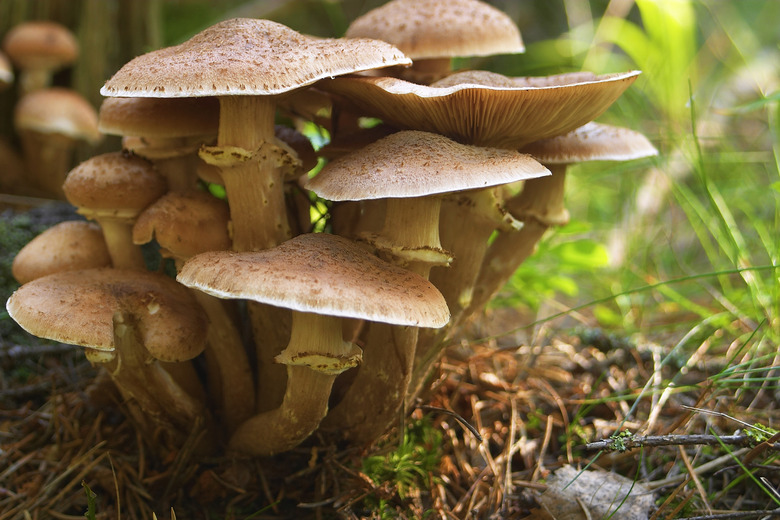What Do Fungi Contribute To The Ecosystem?
Fungi play an important role in energy cycling within, and between, ecosystems. Fungi are found in terrestrial, marine and freshwater environments, and are part of a diverse community of "decomposers" that break down dead plants and animals. Aside from fungi, this community includes bacteria, tiny invertebrates, such as nematodes, and larger invertebrates, like snails, beetles and earthworms. Fungi transform organic matter into forms that can be utilized by other decomposers, and into food for plants.
Decomposition
Decomposition
Fungi live everywhere that moisture is present. They can be found as single-celled organisms, like yeast, that are invisible to the naked eye, and as multiple-celled organisms, like mushrooms, that are made up of strands of cells called "hyphae." Fungi are so widespread and numerous that they make up a large proportion of the biomass in any given ecosystem. Fungi play a very important part in the decomposition process, because they can break down tough organic materials, such as cellulose and lignin, which invertebrates find difficult to digest. Fungi release digestive enzymes that are used to metabolize complex organic compounds into soluble nutrients, such as simple sugars, nitrates and phosphates. Unlike animals, that digest food inside their bodies, fungi digest food outside of their "bodies" and then absorb the nutrients into their cells.
Nutrient Cycling
Nutrient Cycling
Plants require nutrients for growth, but nutrients are seldom freely available in soil or water because they are locked up in insoluble compounds. Plants therefore rely on decomposers to provide them with soluble nutrients that can be taken up by roots. For instance nitrogen, one of the most important plant nutrients, is locked into proteins that are not easily taken up by plants — although some plants have been shown to do so. Fungi metabolize proteins, and release inorganic forms of nitrogen, such as nitrate, that can easily be taken up by plant roots. In freshwater environments fungi are instrumental in the transfer of energy from riparian forest to aquatic ecosystems, by decomposing wood and leaf litter that fall into the water. In terrestrial systems, fungi transfer energy from above the ground, to below it, where it is recycled back to plants.
Symbiosis
Symbiosis
Some species of fungi form symbiotic relationships with plants. Mycorrhizal fungi are associated with plant roots. This relationship is mutually beneficial because fungi facilitate the transfer of nutrients from the soil into plant roots, and in turn receive carbon from the plant. Carbon is stored by fungi in the soil and therefore is not released as carbon dioxide. It was once thought that plants were the only source of carbon for mycorrhizal fungi. However, an article published in the May 2008 issue of "Functional Ecology" reveals that mycorrhizal fungi can actively decompose organic carbon, and therefore play a greater role in carbon loss and input from soil than previously thought. Lichens are another type of fungi that form a symbiotic relationship, but they do so with cyanobacteria. Lichens provide shelter for the bacteria, which in turn make energy and carbon for lichens via photosynthesis.
Food Source
Food Source
There are many animals that rely partially, or wholly, on fungi as a food source. Herbivorous mammals tend to be opportunistic fungus feeders, eating fungi if they come across it while browsing in the forest. However, for some animals fungi makes up a large part of their diets. Examples are the caribou, which relies heavily on tree lichens for food during the winter when leafy foods are not available, and the long-nosed potoroo, an Australian mammal whose diet consists almost entirely of fungal fruiting bodies. Many invertebrates also eat fungi, both opportunistically and actively. Stream invertebrates receive extra energy when they eat decaying leaves that have fungi growing on them. Banana slugs are commonly observed feeding on mushrooms and other fungi, which they appear to favor over other foods.
Cite This Article
MLA
Campbell, Kirsten. "What Do Fungi Contribute To The Ecosystem?" sciencing.com, https://www.sciencing.com/fungi-contribute-ecosystem-21989/. 9 March 2018.
APA
Campbell, Kirsten. (2018, March 9). What Do Fungi Contribute To The Ecosystem?. sciencing.com. Retrieved from https://www.sciencing.com/fungi-contribute-ecosystem-21989/
Chicago
Campbell, Kirsten. What Do Fungi Contribute To The Ecosystem? last modified August 30, 2022. https://www.sciencing.com/fungi-contribute-ecosystem-21989/
